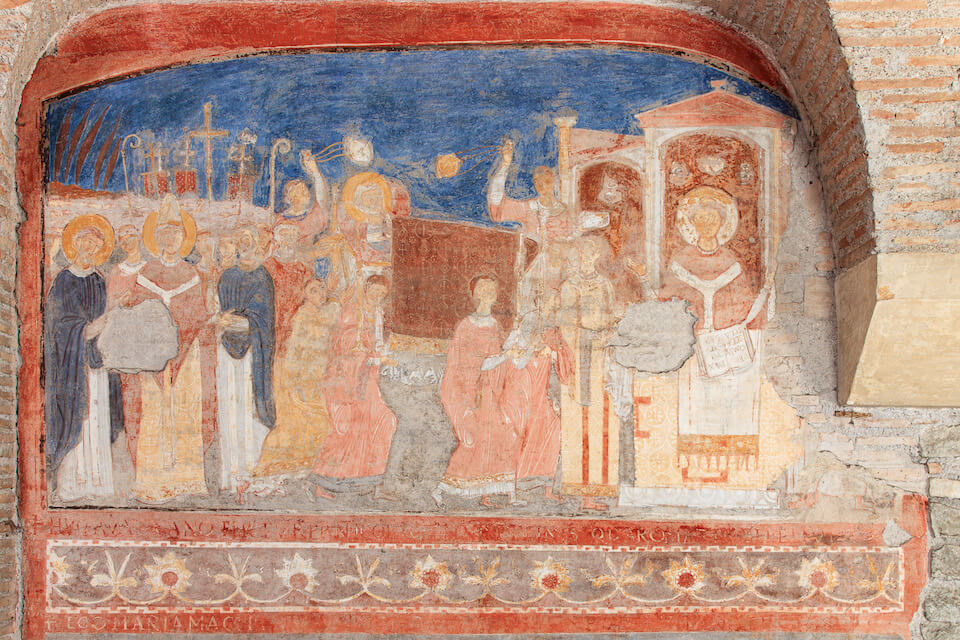Our Rome private tours are a unique opportunity to delve into the life and faith of the earliest Christians. Following the Edict of Milan in 313, decreed by the great Constantine, the consequences for religious life in Rome were such that the 4th and 5th centuries were defined as particularly flourishing periods for church construction. Each guided tour of these basilicas is a historical and religious journey to appreciate the beauty of the mosaics and architecture of these ancient places of worship.
Which are the best Basilicas and Churches witnessing Early Christian Art & Architecture?
Basilica of San Lorenzo outside the Walls: a Masterpiece of Paleochristian Architecture
The first basilica near the tomb of the martyr Lorenzo was erected in the 4th century by Emperor Constantine. The basilica is considered one of the Seven Churches and was included among the four patriarchal basilicas until the 19th century. It has been restored and expanded several times, showcasing the highest craftsmanship in marble mosaics and the Cosmatesque floor, one of Rome’s most beautiful. Additionally, the high columns behind the tomb raise one of the rare examples of matroneums in Rome. The tomb of Pope Pius IX is preserved beneath the altar.
Basilica of San Agnese outside the Walls: a Monumental Complex of Early Christianity
This monumental complex best testifies to the Paleochristian and medieval age in Rome. The basilica, one of the purest examples of Byzantine style in Rome, still preserves the exciting and splendid mosaics of the 7th century in the apse. The Mausoleum, built in the 4th century by the daughter of Emperor Constantine, is a fascinating circular building with the vault of the ambulatory entirely adorned with precious Roman mosaics from the 4th century.
Basilica of Santa Sabina on the Aventine: the perfect Model of a Christian Basilica
Founded in 425 AD on a Titulus Sabinae established in the house of a matron named after the saint, it is considered the most perfect model of a Christian basilica of the 5th century. The solemn and luminous interior, which for the first time recalls the prototypes of the Ravenna basilicas, consists of three aisles of classic proportions divided by 24 Corinthian columns. We will also visit two archaeological areas below the Basilica, among the most suggestive of the Roman underground, and the beautiful medieval Cloister, the Cell of St. Dominic decorated by Bernini, and the brand new Diocesan Museum inside the Convent.
Basilica of San Clemente: unraveling the Layers of Roman History
Discover the basilica, which constitutes one of the most extraordinary and well-preserved monumental “palimpsests” in the city. Only here can one clearly and unequivocally grasp the sense of architectural and artistic continuity, which constitutes the best example of historical stratification that Rome can show. From the important archaeological evidence to the medieval suggestions of the basilica, everything contributes to making a “journey” through the centuries fascinating and unmissable.
Basilica of San Crisogono in Trastevere and its Underground Spaces
The archaeological area with the remains of the titulus Chrysogoni, built on a domus transformed perhaps into a domus ecclesia, one of the very first Christian places of worship of a domestic nature, is one of the most suggestive environments of the Roman underground. Fragments of orientalizing frescoes from the 9th century with theories of saints and other high medieval frescoes with the “Stories of St. Benedict and St. Sylvester” make this place one of the most extraordinary examples of archaeological and artistic stratigraphy in Rome. The current upper basilica, erected in Trastevere at the beginning of the 12th century, preserves a splendid medieval apse mosaic and a beautiful Cosmatesque floor.
Basilica of Santa Maria in Trastevere: the Heart of Medieval Rome
In the heart of Trastevere, in one of the squares most loved by Romans, the Basilica, traditionally considered the first official place of Christian worship in Rome and the first church dedicated to Mary, stands. Its medieval imprint is still strong with the portico and the Romanesque bell tower from the 12th century; magnificent are also the mosaics of the apse and the frescoed panels below by the great Roman master Pietro Cavallini at the end of the 13th century. We will visit the underground areas of the Basilica to “explore” a vast archaeological complex from Roman times consisting of a series of dwellings and environments dating from the Republican era to the 4th century AD.
Basilica of Santo Stefano Rotondo: the Oldest Circular Church in Rome
Reopening after many years of restoration, one of the most suggestive and exciting churches in Rome. Located on the ancient Via Celimontana and on the remains of the Castra Peregrina, it is the oldest circular church in Rome. The vast interior consists of a circular ambulatory closed by a wall with 34 ancient columns and a central part separated by 22 granite columns. On the walls of the perimeter wall, there is a famous cycle of frescoes made by Pomarancio and Antonio Tempesta depicting scenes from the Martyrology.
Basilica of Santa Cecilia: a Testament to Roman Artistry
Built on the foundations of a Roman domus still existing that would have belonged to Valerian and his wife Cecilia, it is one of the most exciting churches in Rome. We will visit, inside the Benedictine Convent, the wonderful frescoes by Pietro Cavallini, masterpieces of Roman painting from the late 13th century, and the church with the beautiful apse mosaic and the ciborium by Arnolfo di Cambio. We will descend into the Basilica’s underground to “explore” a vast archaeological complex from Roman times consisting of a series of dwellings and environments dating from the Republican era to the 4th century AD.
Basilica of the Holy Four Crowned Martyrs: a Medieval Gem in Rome
A visit to one of the most suggestive medieval churches in Rome: its matroneums, the beautiful Cosmatesque floor, the suggestive cloister among the most beautiful in Rome, and the magnificent oratory of San Silvestro entirely decorated with a cycle of frescoes from the 13th century make it one of the few places where you can still “experience” the charm of the Middle Ages. During recent restorations inside the Monastery, a cycle of frescoes considered of fundamental importance for documenting Roman Gothic art has been recovered.
Basilica of San Lorenzo in Lucina: traces of Roman History
The current basilica originates from the ancient Titulus Lucinae, in turn built on a Roman domus where two construction phases can be distinguished, dating back to the 2nd and 3rd centuries AD. Our visit will take us to the undergrounds of the current church where we can admire the structures related to the Roman domus and the remains of the Paleochristian basilica from the 5th century AD. We will also visit the places where Emperor Augustus had some symbols of his power built: the Ara Pacis and the Horologium Augusti.
Ara Coeli and Mamertine Prison: witness to Christian Persecution
High on the Capitoline Hill, in the place where the Temple of Juno Moneta stood, stands the majestic Basilica of Santa Maria in Ara Coeli, rich in history and memories, elegant and austere, guardian and witness of rare beauty. Just in front of the Arch of Septimius Severus in the northern area of the Roman Forum, we will visit the Tullianum, the ancient Mamertine Prison, witness to the imprisonment of the Apostles Peter and Paul. An archaeological area recently reopened to the public, located under the Church of San Giuseppe dei Falegnami, where the rooms used as a “Carcer” during imperial times are visitable, as well as remains of the Servian and Republican walls in the presence of an ancient water source still visible.
Basilica of Saints Cosmas and Damian and Underground Spaces: a Glimpse into Imperial Rome
In the heart of the Imperial Fora, founded precisely where Emperor Vespasian had built the Temple of Peace, on the walls of which the famous Forma Urbis was affixed, and incorporated within the so-called Temple of Romulus along the Via Sacra in the Roman Forum, the Basilica of Saints Cosmas and Damian still preserves in the apse the wonderful 7th-century mosaic, considered the stylistic and iconographic model of all medieval mosaics made in Roman churches. We will also visit, in the undergrounds of the current church, the suggestive primitive building located at the level of the Roman Forum.
| BROWSE OUR TOURS |
Keep reading:


 WhatsApp us
WhatsApp us